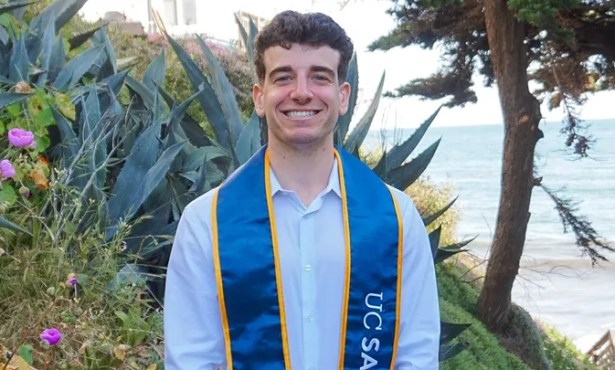Sanchez Walks Back Complaint, Sort Of
Cops Still Worry About Catch-and-Release for Burglars

Governor Jerry Brown may have proclaimed California’s long-festering prison overcrowding crisis done with, but Santa Barbara Police Chief Cam Sanchez ain’t buying it. While the governor’s vaunted “realignment” program reduced congestion in state lockups, Sanchez contended Brown only shifted the burden to California’s 58 counties, now charged with incarcerating and supervising inmates who ordinarily would serve out their sentences behind state bars.
Last week, Sanchez stepped on more than a few toes when he declared, in front of the City Council, that fully half the people his officers had arrested on residential burglary charges last November would be in custody were it not for AB 109, the complex state law embodying the governor’s “realignment.” It was an alarming claim, and many in the county Probation Department — as well as the County Jail — wondered where Sanchez had gotten his data.
It turns out Sanchez had exaggerated significantly. Upon closer reflection, Sanchez would be informed by members of his department that the accurate number was 17 percent. In a letter mailed to County Probation Chief Beverly Taylor and Jail Commander Jim Peterson, assistant police chief Frank Mannix apologized on his boss’s behalf “for any consternation that [Sanchez’s] comments may have caused.” Mannix explained the origin of the confusion, stating that during a staff meeting, the sergeant in charge of burglaries “noted 50 percent of the time when we do searches on the homes of AB 109 suspects, it results in arrests.”
If Sanchez goofed, it’s in part because AB 109 is so confusing. It contains enough alternative sentencing formulas — all designed to keep nonviolent offenders charged with “nonserious” felonies out of state institutions — to challenge the skill and patience of many judges, prosecutors, and defense attorneys. Passed in 2011, the law has not been in effect long enough to truly quantify the demand it’s placed on Santa Barbara County’s excruciatingly cramped jail space. But anecdotally, it’s made a bad situation even worse.
“People we’re popping for residential burglary are getting cut loose,” he said. “Some are re-offending. There are a lot of reasons why the jail is overcrowded. But part of the problem has to do with AB 109. We’re not pointing fingers or blaming anyone. This is the environment throughout California.”
Santa Barbara police spokesperson Sergeant Riley Harwood expressed frustration that people charged with property crimes are now being released much sooner after booking than they were prior to AB 109. “People we’re popping for residential burglary are getting cut loose,” he said. “Some are re-offending. There are a lot of reasons why the jail is overcrowded. But part of the problem has to do with AB 109. We’re not pointing fingers or blaming anyone. This is the environment throughout California.”
In response to this frustration, Harwood said the department is now giving serious consideration to pulling cops off the beat-coordinator assignment, the traffic beat, and the homeless street-crime detail — all popular programs with the public — and redeploying them to focus on property crimes. Residential burglary is way up, Harwood noted. This December, the police department fielded 35 complaints about home burglaries; last December the number was 23. But the statistics are not so stark when it comes to connecting the uptick in burglaries with repeat offenders who’d otherwise be behind bars were it not for AB 109.
According to the police department’s revised numbers, two of the 13 burglary arrests — both residential and commercial — that occurred last October and November involved individuals under county probation supervision under AB 109. While not outright contradicting the police department’s assertions, County Probation Chief Beverly Taylor released a statistical snapshot of the county’s AB 109 caseload that’s less clear-cut.
Since the program went into effect October 2011, Taylor said that County Probation has handled 421 AB 109 cases. Of those, 63 were inmates who finished their state sentences by splitting time between County Jail and some form of more intensely supervised probation. Of these, Taylor said one was convicted for a new felony offense — drug-related — and three for new misdemeanors. Two of those were drug-related, and one was for petty theft. The vast bulk of the AB 109 population — 358 — however, are placed either on electronic monitoring or on probation, again more supervised than typical county probationers. Of these, Taylor said 6.9 percent — or 26 individuals — were charged with additional felonies in the first year, and 12.6 percent — 52 individuals — were charged with new misdemeanors. No breakdown of what those offenses were was provided.
In response to the AB 109 realignment, county jailers have been forced to expand the existing electronic monitoring program, allowing the courts to sentence those convicted of crimes to their own homes. While the absolute number of such sentences has held pretty steady from last October to December, the number of “re-alignees” increased from 18 to 37. In that time, three sentenced to the electronic bracelet were arrested on new charges, but none were AB 109 inmates. Likewise, 36 of the 155 jail inmates given early release from County Jail in the same three-month period were AB 109 inmates.
While AB 109 is adding to the crunch for space that’s plagued the jail for years, it’s unclear exactly by how much. In the past, released state prisoners who violated conditions of their parole on technical rather than more substantial grounds would have been remanded to state prison. Now, they are sent to County Jail. Whatever the precise cause, the jail experienced a dramatic increase in the number of “floor-sleepers” — inmates for whom no bunk is available — that corresponds to the implementation of AB 109. In 2010 and 2011, the average number of inmates a night for whom no bunk was assigned was three and four, respectively. In 2012, the number had skyrocketed to 28 a night.



